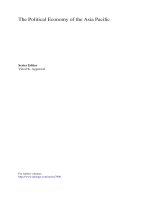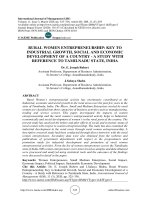Economic growth and economic development 376
Bạn đang xem bản rút gọn của tài liệu. Xem và tải ngay bản đầy đủ của tài liệu tại đây (44.14 KB, 1 trang )
Introduction to Modern Economic Growth
different from finite-dimensional maximization, and when such infinite-dimensional
maximization problems may fail to have solutions.
For economists, books that develop the theory of optimal control with economic
applications may be more appropriate. Here the best reference is Seierstad and
Sydsaeter (1987). While not as rigorous as Fleming and Rishel (1975), this book
also has a complete proof of the main results and is also easier and more interesting
to read for economists. It also shows how the results can be applied to economic
problems. Other references in economics are Kamien and Schwartz (1991) and
Leonard and Van Long (1992). Another classic is Arrow and Kurz’s (1970) book,
which covers the same material and also presents rich economic insight on growth
theory and related problems. This book also states and provides a proof of Arrow’s
sufficiency theorem, which also appears in Arrow (1968).
Two recent books on applications of optimal control in economics, Caputo (2005)
and Weitzman (2003), might be more readable. My treatment of the sufficiency
results here is very similar to Caputo (2005). Weitzman (2003) provides a lively
discussion of the applications of the Maximum Principle, especially in the context
of environmental economics and depletion of natural resources.
There is some confusion in the literature over the role of the transversality condition. As commented in the previous chapter, in general there need not be a single
transversality condition, since the transversality condition represents the necessary
conditions obtained from specific types of variations. The example provided in Section 7.4 shows that the stronger transversality condition, which is very useful in
many applications, does not always hold. This example is a variant of the famous
example by Halkin (1974). The interested reader should look at Michel (1982),
which contains the original result on the transversality condition of (7.44) for discounted infinite horizon optimal control problems and also a discussion of when the
stronger condition (7.55) holds. The results presented here are closely related to
Michel’s (1982) results, but are stated under assumptions that are more relevant
in economic situations. Michel assumes that the objective function is nonnegative,
which is violated by many of the common utility functions used in economic growth
362









